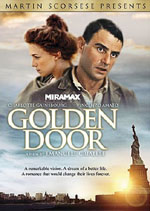 GOLDEN DOOR
GOLDEN DOOR
(PG-13)
MOVIE: **1/2 (out of 5)
DVD EXPERIENCE: ** (out of 5)
STARRING
Charlotte Gainsbourg as LUCY REED
Vincenzo Amato as SALVATORE MANCUSO
Aurora Quattrocchi as FORTUNATA MANCUSO
Francesco Casisa as ANGELO MANCUSO
Filippo Pucillo as PIETRO MANCUSO
Studio: Miramax
Directed by: Emanuele Crialese
BY KEVIN CARR
Just because Martin Scorsese puts his name on a film does not mean you should run out and see it. Sure, he’s now an Oscar-winning director, but his endorsement for “Golden Door” is a little too high profile on the DVD box. It’s like renting some crappy 1980s Hong Kong action flick just because Quentin Tarantino slaps his name on the credits.
“Golden Door” is an Italian-language period piece that profiles the life of a family immigrating from Sicily to the U.S. at the turn of the 20th century. Vincenzo Amato plays Salvatore Mancuso, who has come to America in search of prosperity. In the old country, there’s rumors of crops yielding vegetables the size of a human and rivers that run full of milk. However, upon coming across the Atlantic with his brother, his feeble mother and his mute son, Salvatore is awakened to some harsh realities.
After listening to the introduction of the film by Martin Scorsese, I can understand his connection to the movie. As a son of Sicilian immigrants, Scorsese praises the director for giving us a very realistic portrayal of the immigrant experience. I would imagine that if you have a close connection to Ellis Island immigrants, you will be similarly touched by this movie.
While I come from turn-of-the-century immigrant families on both sides of the family (Irish from my dad’s side and Hungarian from my mother’s), I got lost in the overbearing nature of the film’s art. The majority of the film is a visceral, realistic portrayal. Yet, here and there, director Emanuele Crialese dips into experimental and surreal techniques to punctuate the film. These sequences include the cast swimming in rivers of milk, carrying giant vegetables and the soundtrack breaking into an anachronistic blues set.
The Italian-language behind-the-scenes featurette included in the special features highlights Crialese’s desire to portray the immigrants based on their Ellis Island photographs. However, he takes things too far with their wide-eyed looks. He treats them more as dumbstruck animals rather than people who culturally never have seen a camera before.
I suppose there can be parallels made between this film and the treatment of immigrants of the day. However, the director’s message of poor treatment (including IQ tests given to the immigrants) fades in light of the open-door policy leading thousands into a current American entitlement system.
